The updates to Cogmind’s fabrication system aren’t exactly an “overhaul” to the extent seen with our other Beta 11 modifications in this series, and not like the one back in 2016 when the process was greatly simplified from its original early alpha form. As you’ll see this is more of a rebalancing, though it does make several important changes including the introduction of a new mechanic and type of part to go along with it, affecting the overall feel and accessibility of fabrication for different builds.
Fabrication is an interesting topic in the context of Cogmind because adapting your build based on what you find and salvage is a major part of the experience, and yet here is a system outside that process with the potential to enable the tightest level of control over your build. So naturally I’ve always wanted to limit the amount of fabrication possible across a run, but just how to best limit it has been in flux.
Prior to the changes in Beta 11, fabrication has been fairly tightly coupled to machine hacking capabilities. That is, with enough hackware you could pretty easily both get the schematics you want and build them at one or more Fabricators to significantly flesh out a build. Moreover, builds capable of this approach (fast/evasive/intel-oriented builds) are less likely to lose parts to begin with, making it easier to coast along with a very stable build. Now I don’t want to completely remove this strategy--it can certainly be an interesting way to play, with its own challenges, but I believe it should be a little harder to execute than what we’ve seen so far.
Limitations
For a long while the main global limitation on fabrication involved the map-wide “central matter system,” which contributed the matter required to build parts or robots at a Fabricator. The system’s matter would be replenished at various intervals, and the more matter drained by unauthorized player-initiated builds relative to the amount of matter remaining in the system, the more likely to be discovered and have the entire system shut down permanently (as far as the player’s time on the map is concerned).
So the rate of fabrication depended on the matter costs of building a given set of schematics vs the rate of replenishment, while being able to build anything at all was contingent on not being discovered (which would always happen eventually, but involved a fair bit of randomness--sometimes very quick, other times allowing for many parts or robots to be built).
I do like the idea of central systems that can be hooked into other pieces of the content, as these are the sort of connections that really help bring a world to life, but aside from the disabling of matter-related machines reducing the reserves available for fabrication across the map (a fairly opaque connection, to say the least), there were no other links made here. Based on how many such mechanical or thematic connections there are elsewhere in the world, people kept assuming or hoping they could add matter to the system at Recycling Units by recycling parts, but for various reasons I didn’t want that to be a thing.
Beta 11 removes the central matter system entirely, and by extension there are no more map-wide lockouts. Certainly no big loss here, and players will be really happy with these changes, though of course I’m still going to want some limitations here, so what’ll it be…
The aforementioned hacker-fabber strategy remains largely intact, but hackers now have a one-build-per-Fabricator limit, because as soon as an unauthorized build is initiated, that machine is locked (but will still finish the job) and an investigation squad is sent to the area. This latter element will add an extra challenge to obtaining parts/allies this way by eventually increasing the number of local hostiles, though both finding more Fabricators (to perform more builds) and evading, distracting, or recalling the investigation(s) are feats well within a hacker’s area of expertise.
Based on what I’ve seen in player runs, and the way the numbers balance out, this change will ultimately have a relatively minimal impact on what is possible for hacker-fabbers to achieve (though again there might be some extra challenge involved). While under the central matter system it was nice that there could be a bit of a choice in there with regard to pushing for faster fabrication at the cost of a higher risk of discovery, by design that system was fairly opaque and therefore difficult to strategize around. By comparison, this newer system is reliably consistent with clear consequences, which is generally preferable with an extensive central system like this.
(It’s also worth noting here that the “preloaded schematic” mechanic remains intact, and building one does not count as an unauthorized build, so getting lucky with a good preloaded schematic you want is still a nice thing to find. Internally I even expanded that system as I’ll describe later.)
So hackers can now enjoy the removal of global rate limitations, and more predictable fabrication potential rather than sudden complete lockouts after a single build or two, but this update is about much more than that, because in addition to increasing reliability while reducing some of the potential for excessive fabrication by hackers, non-hackers are also getting a new way to reliably fabricate something via *gasp* a new consumable!
Authchips
Fabricators don’t need to be a resource limited to hackers (or anyone who happens across a lucky preloaded schematic)--why not include another option for accessing them which different build styles can also take advantage of? I’ve generally tried to avoid consumables in Cogmind (and written as much about it before), but as with Relay Couplers I believe there’s room here for a new tool and limiting factor in terms of how non-hackers can utilize Fabricators.
“Authchips” are a new type of consumable item that can each be used once to load and build a single schematic. Success is guaranteed, and using one does not cause any detection, tracing, or other negative side effects. There being no explicit central matter system anymore, and no more lockouts, Authchips essentially allow for otherwise unlimited and safe fabrication so long as one has the necessary chips.
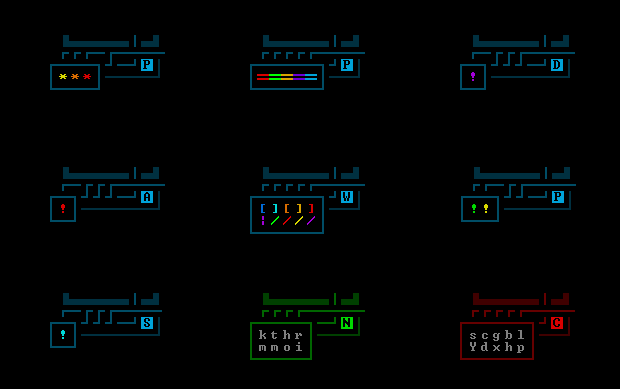
Authchips!
Technically an Authchip must be attached in order to use it for fabrication, a requirement which allows for them to come with corruption as a possible drawback, while more importantly also making this feature compatible with the UI in that by attaching an Authchip of a given type, it can be assumed the intent is to use the Authchip rather than attempting to hack the target instead (there is no explicit choice available via the Fabricator interface).
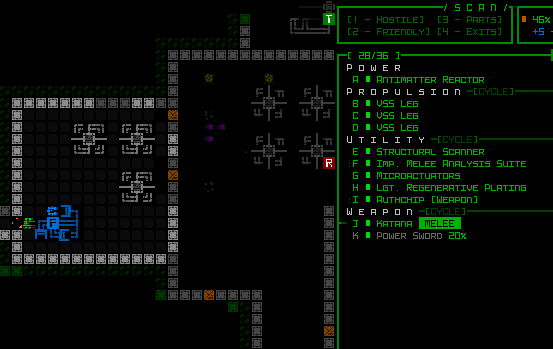
An example of using an Authchip to immediately start building something that would otherwise be pretty tough in that situation (notice the special color and indicator in the schematics list).
Scoresheets have also been updated to include Authchip indicators.
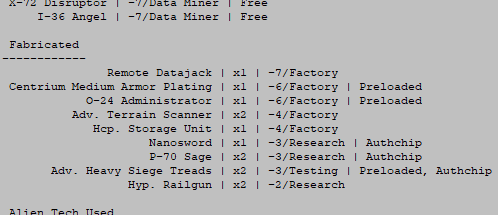
We can now also tell from scoresheets whether an Authchip was used for a given fabrication.
Balance Factors
Obviously with success at a Fabricator guaranteed and without consequences, Authchip design needs to rely on other factors to ensure balance.
First and foremost is acquisition, or how and whether the player can obtain Authchips to begin with. On this front I added quite a few sources, but admittedly almost none of them are guaranteed. This is more in line with Cogmind’s philosophy of “I have found this interesting new option, should I take advantage of it?” over “I have a very specific plan and am going to execute it to a tee.” The former is much more roguelike in spirit. Two of the Authchip sources are guaranteed, but each of those comes with its own drawbacks and is therefore not necessarily something everyone would want or even be able to do. Instead the general idea is that players may randomly encounter one of the many different possible Authchip sources and have to decide then and there whether they have (or will seek out) a desirable schematic and want to allocate the required inventory space until they reach a Fabricator. (Update: I’ve since written about the primary guaranteed Authchip source, DSFs.)
A second balance factor likely apparent from the earlier demo gif is that “Authchip” is not a single item, but a group of items which each apply to different part categories, as with Relay Couplers indicating their relevant category in brackets. The main issue with consumables (and basically any non-part item) revolves around making sure they’re worth the slot requirement and/or inventory space compared to whatever else they might be displacing. Based on their intended frequency, allowing a single Authchip to build any schematic whatsoever would have far too much versatility for the goal I’m aiming for, but fully splitting them into a 1:1 ratio with item types would be excessively limiting, so I’ve chosen a middle path that divides them by slot type while further subdividing utilities (the bulk of Cogmind items) into four main categories, giving us Authchips for Storage, Devices, Processors, and Armor in addition to the slot-based Power, Propulsion, Weapons. Robots, mostly a sideshow when it comes to discussing fabrication so I haven’t been mentioning them much so far, simply add two more types of chips, Combat and NC (non-combat, using the same abbreviation found on couplers).
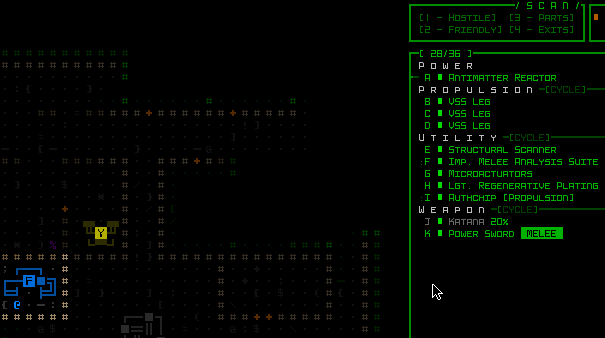
Another Authchip fabrication demo, this one of the [Propulsion] type.
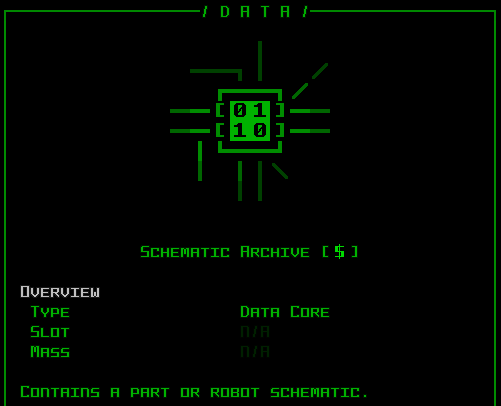
Someone in Zion probably owns a lot of these.
The nice thing here is that new strategies and tradeoffs will appear now that technically any build has access to Fabricator use assuming they have the schematic and can acquire Authchips, at least any build willing to temporarily sacrifice inventory for the promise of being able to eventually build something neat later (there are no rating limits on what can be built at any Fabricator, so it really is all about getting the desired schematic).
Complex-initiated Fabrication
Complex 0b10’s Fabricators weren’t installed as a friendly gesture to intruders. They’re of course one of the main sources of Unaware robots and parts, albeit mostly built at some time prior to your own arrival (or after your departure). Still, this being a living world it’s nice to see evidence of it actually happening, so for a long while now Fabricators have actually been able to produce things, where any parts built are picked up by a Hauler which takes them from the map, or any combat robots built head off to report to a Garrison. It’s not incredibly common, plus it could can happen at any Fabricator on the map, so the chances of coming across it are not all that high, but it does happen.
Now in the past the implementation of this feature took the easy route (as rare low-impact content tends to do if it won’t make much difference), with simply a small random chance each turn that a random Fabricator somewhere on the map would suddenly spit something out as described above. The problem with this approach is that internally it didn’t follow the normal fabrication rules, in that there’s no real production process, nor is the proper schematic even loaded on that machine--it just… happened.
Not a big deal before since this behavior was mostly fluff, but along with the fabrication system changes, it turns out we needed to remove or replace some hacks, since the matter-related stuff from before no longer applied. When updating content, wherever possible I prefer replacement over removal, as this helps feature modifications either increase the amount of content or at least keep it stable, and also forces a bit of creativity (“what would this feature do instead under this scenario?”) which can have unexpected and fun results!
A Fabricator’s Network(Status) command/hack was originally meant as an easy way to check on the current central matter reserves, but instead of removing it, what better new purpose than to tell you what all the Fabricators are really up to? …If only the Complex actually knew :P
Fortunately with a fabrication rework comes more time to focus on the system and a greater desire to expand and perfect it, so 0b10 will now preload schematics for what it’s planning to build, actually puts in the time required to do so, and Network(Status) reports the details.
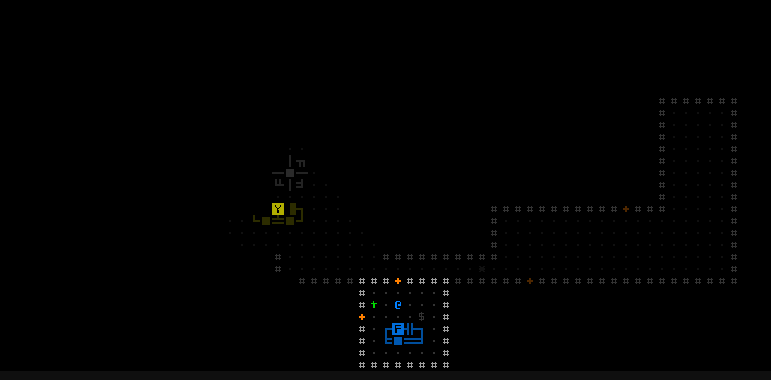
Network(Status) effect under the new fabrication system.
In that gif above you’re also seeing a new purpose for the Map Comments feature: automated comments! It wouldn’t make much sense to give all this network status info if there wasn’t an easy way to reference it. It’s the kind of information players would want to consider taking notes on, or add their own comments via that UI feature, but in any case we may as well just have all that happen automatically.
You can edit and remove these map comments as normal during comment editing. The system is also smart enough to automatically remove/update existing Fabricator comments if the situation has changed by the next time you run that hack.
Similarly one of the Fabricator Trojans was given new functionality, which also makes use of automated map comments to report on fabrication processes in real time wherever you are.
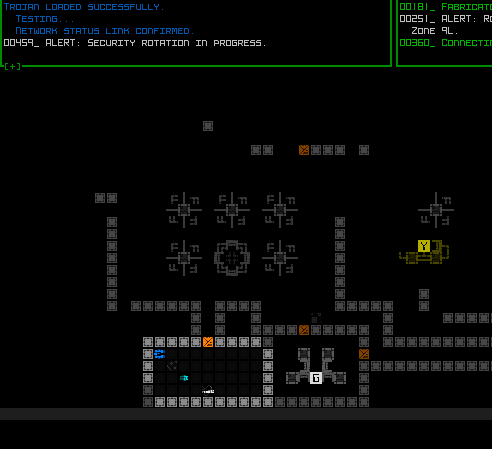
Real-time map-wide fabrication reporting adding automated comments to the map. As you can see here automated map comments in particular will appear in a different color to differentiate them from those you’ve added on your own (the Network(Status) gif further above was recorded before that change was made).
While expanding the system I also added a couple new Fabricator Trojans to discover for fun :D
Results
I started brainstorming changes to the fabrication system a year ago in reaction to lots of recurring player discussion on the topic, and more recently spent a couple months revisiting possible concepts a few times, sharing some of the process with patrons while refining it further each time.
The process was supposed to culminate in a “purely experimental” test release to see if this whole Authchip idea would work or if we might want to roll back any changes and continue looking for other systems. Things didn’t end up playing out that way because following that many refinements, and while eventually starting to implement the foundation, I started getting pretty confident that even if it wasn’t perfect, this design is close enough to the final state to warrant skipping the whole experiment idea and building it in full. So it’s here to stay.
Part of the reason for the late confidence was that the original concepts were more extreme, going as far as considering replacing Fabricator hacking with Authchips or other such heavy-handed requirement, but in the end as you can see the new system is more of a rebalanced and expanded version of what we had before, so a lot easier to predict the results of adding it to the game and I at least don’t see any negative consequences, per se.
The new system has been included in Beta 11 prerelease versions for some weeks at this point, however experience with these bits is still limited so I can’t actually comment on how successful it’s ultimately been. I did make a list of other factors that could be used to further tweak the balance if necessary, though I’m still confident at this point that over time this’ll work out.

